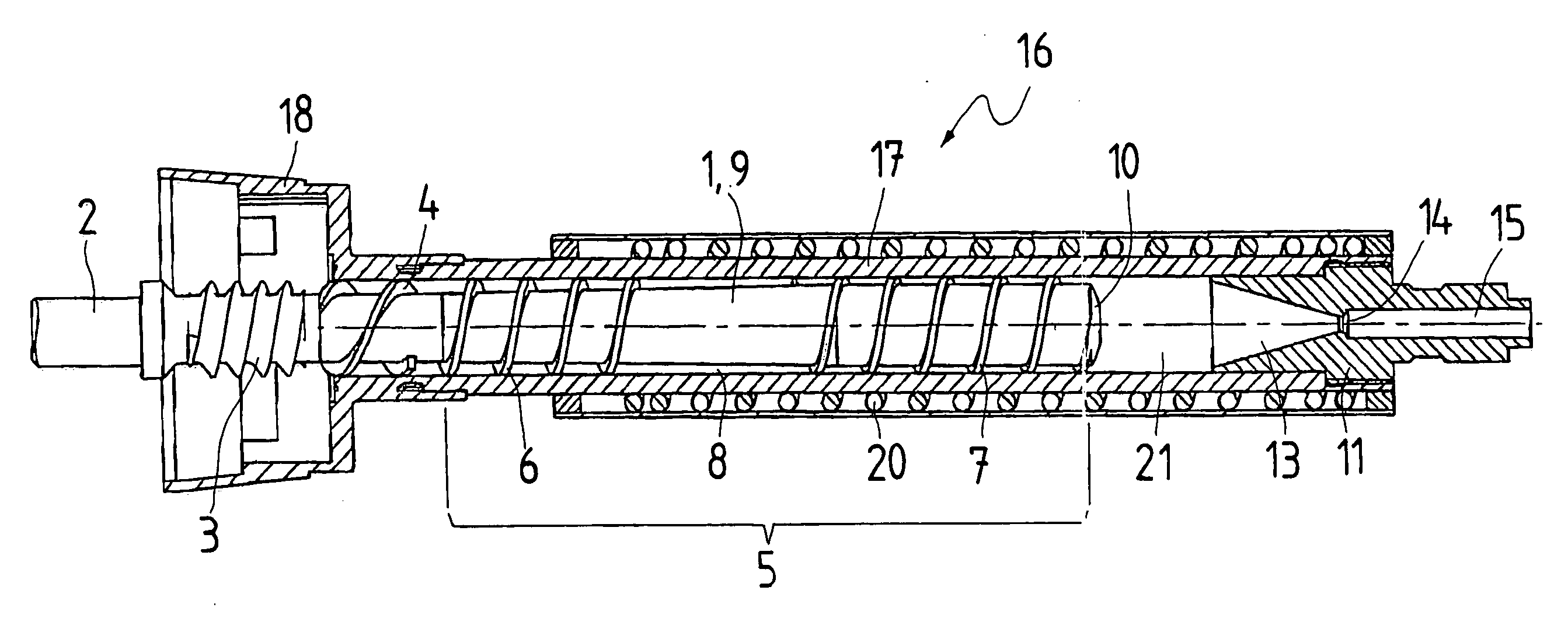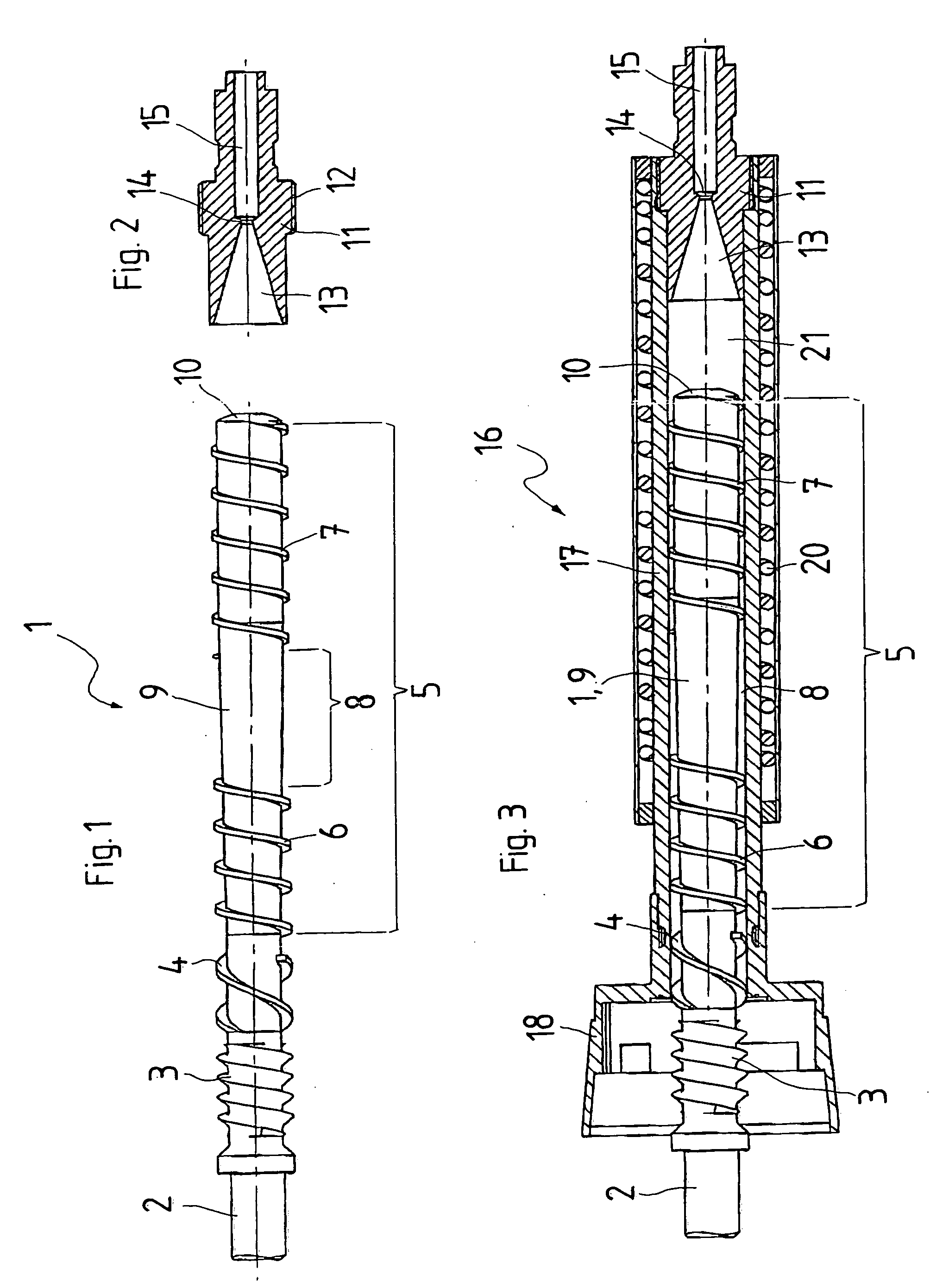[0003] The invention addresses the problem of proposing an extruder with a good degassing effect that avoids gas inclusions in the plasticized compound, or at least reduces them to a minimum.
[0004] The invention solves this problem with the characteristics of claim 1. The extruder screw of the extruder proposed by the invention has two axially spaced screw threads. That means that the
screw thread of the extruder screw is not continuous but that the extruder screw has a thread-less axial area between its screw threads. The thread-less area forms a
buffer zone that serves as a storage space for the not yet completely plasticized compound, on the one hand, and as a degassing zone, on the other hand. Gas, in particular air, included in the synthetic material that is to be extruded but not completely plasticized yet, is expelled against the feeding direction from the synthetic material by the increasing compression of the not yet fully plasticized synthetic material, and flows from the thread-less
buffer zone against the feeding direction of the extruder back to an inlet or feed opening for the synthetic material. In the area of the
screw thread of the extruder screw that comes first in relation to the feeding direction, the synthetic material to be extruded is still present in the form of pieces that may already be partially plasticized and fused together. In the area of the
screw thread of the extruder screw that comes first in relation to the feeding direction, the density of the synthetic material is still low enough to leave sufficient space between the synthetic material pieces for the air displaced in the
buffer zone to escape against the feeding direction, i.e. towards the fill or feed end of the extruder. The buffer zone without a screw thread between the two screw threads of the extruder screw of the extruder proposed by the invention has the effect of degassing the synthetic material to be extruded against the feeding direction of the extruder. Gas inclusions in the plasticized synthetic material exiting from the extruder are avoided completely, or at least to a very large extent.
[0006] Another
advantage of the extruder screw proposed by the invention is that it allows the use of a simple extruder insert, also known as an extruder
nozzle. With the extruder screw proposed by the invention, it is not necessary to use a special extruder insert with multiple deflection of the plasticized synthetic material, possibly even in radial direction, or to separate the plasticized synthetic material in the extruder into several strands by means of a perforated disk, etc. Such special extruder inserts are used in familiar extruders for homogenization, mixing, and pressurizing. Such special extruder inserts are chicanes for the plasticized synthetic material; they have dead zones, i.e. zones with low or zero feeding velocity of the plasticized synthetic material where the synthetic material gets caught for long periods and decomposes. Particles of decomposed synthetic material will then lead to faults in the extruded synthetic compound.
[0008] One design variant of the invention provides for a
smoothing space in the extruder housing in feeding direction behind the extruder screw and in front of an extruder insert. Preferably, this
smoothing space is free of inserts / obstructions. In this
smoothing space, an expansion, mixing, and further homogenization of the synthetic material plasticized by the extruder screw takes place. In addition, the smoothing space has the function of a second storage that makes the exit of the plasticized compound from the extruder more uniform and further reduces the pulsation of the exiting synthetic material.
[0009] One design variant of the invention provides for a simple extruder insert that tapers like a funnel in the feeding direction. Such an extruder insert that is easy to manufacture and avoids a complex flow path of the plasticized synthetic material, its separation into several strands, expansion in a gap, or similar features is made possible by the extruder screw proposed by the invention. The extruder insert offers favorable flow, minimizes shear forces, and reduces self-heating of the extruded synthetic material to a minimum. As an additional
advantage, it has no dead zones where plasticied compound might collect and remain for long periods, and decompose.
[0010] A development of this design variant provides for the extruder insert to have no dead zone in the area of its funnel-shaped taper. Thus, the extruder insert has no inserts, additions inside or ahead of it, and no undercuts etc. that might create, in feeding direction, a dead flow zone or a zone of turbulence behind them, i.e. a zone with reduced flow velocity and / or a long dwell time of the plasticized synthetic material. Specifically, a decrease to a low feed velocity dropping towards zero, and / or a long dwell time of the plasticized synthetic material in the funnel-shaped taper of the extruder insert is to be avoided because this poses the danger of a
decomposition of the synthetic material.
 Login to View More
Login to View More 

